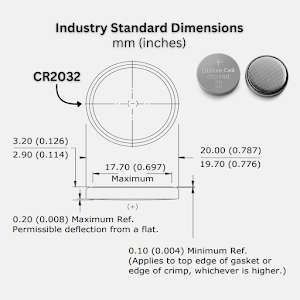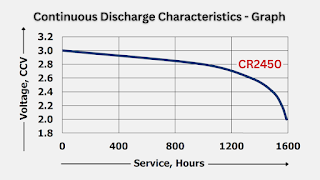
The CR2032 and CR2450 are power sources found in various devices, ranging from watches to calculators, providing the necessary energy to keep our devices running smoothly. These cells are widely utilized in applications where standard cells are ineffective, such as calculators, digital watches, laser pens, vehicle keys, medical devices (like clinical thermometers and tensiometers), and workout equipment. Both cells provide the same 3V output voltage; You can deduce from their differences whether they are interchangeable.
What is the Difference Between CR2032 and CR2450?
CR2032 and CR2450 are non-rechargeable 3V coin cells from the CR series, composed of lithium-manganese dioxide (LiMnO2) without added mercury. They have an ultra-compact design, very low self-discharge (~1% per year), and a long shelf life of up to 10 years, featuring high leak protection. Both cells are suitable for a wide range of temperatures, from -30°C to +60°C.

|

|
| 2D Model and Dimensions for designing a PCB or Perf board with CR2032. | 2D Model and Dimensions for designing a PCB or Perf board with CR2450. |
The sole reason for the difference between them is the COMSAN battery standard coin or "button-shaped" sizes and their storage capacity. The CR2032 cell has a capacity with a diameter of 20mm and a thickness of 3.2mm, while the CR2450 cell has a capacity of 620mAh with a diameter of 24mm and a thickness of 5mm. Due to the size compatibility limitations, they are not interchangeable in device operation.
Note: Complete technical information about these two lithium cells can be found in the Energizer CR2032 datasheet & Energizer CR2450 datasheet. You can download it.
CR2032 Vs. CR2450: Continuous & Internal Resistance Characteristics
The following table of CR2032 Vs. CR2450 shows the Continuous Discharge Characteristics when a load is connected to them, and Internal Resistance Characteristics due to the opposition of the flow of current, which is offered by the cell itself (prevent you from drawing maximum current from the cell):
To conclude, the CR2032 and CR2450 are both widely used lithium cells, each with its own set of applications. While they offer different capacities and sizes, neither of them is rechargeable due to their chemical composition. Understanding the characteristics and limitations of these cells is crucial for proper device operation and cell management.










No comments
If you have any doubts or questions, please let me know. Don't add links as it goes to spam. Share your valuable feedback. Thanks